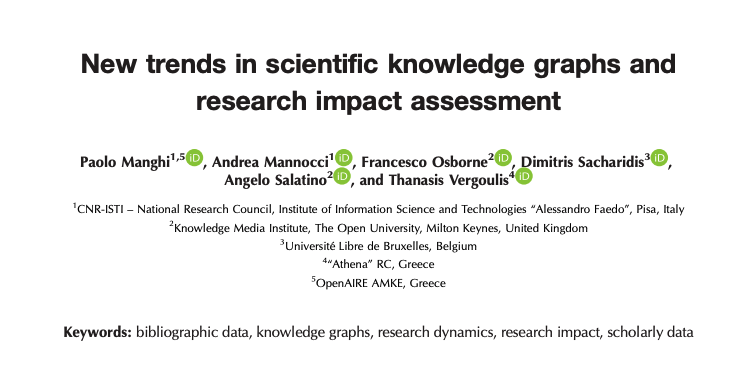“New trends in scientific knowledge graphs and research impact assessment” is the introductory chapter of the Special Issue on “Scientific Knowledge Graphs and Research Impact Assessment” at Quantitative Science Studies (QSS by MIT Press).
Paolo Manghi1, Andrea Mannocci1, Francesco Osborne2, Dimitris Sacharidis3, Angelo Salatino2, Thanasis Vergoulis4
1 CNR-ISTI – National Research Council, Institute of Information Science and Technologies “Alessandro Faedo” (Italy)
2 Knowledge Media Institute, The Open University, Milton Keynes (UK)
3 Université Libre de Bruxelles (Belgium)
4 “Athena” RC (Greece)
Introduction
In recent decades, we have experienced a continuously increasing publication rate of scientific articles and related research objects (e.g., data sets, software packages). As this trend keeps growing, practitioners in the field of scholarly knowledge are confronted with several challenges. In this special issue, we focus on two major categories of such challenges: (a) those related to the organization of scholarly data to achieve a flexible, context-sensitive, fine-grained, and machine-actionable representation of scholarly knowledge that at the same time is structured, interlinked, and semantically rich, and (b) those related to the design of novel, reliable, and comprehensive metrics to assess scientific impact.
To address the challenges of the first category, new technical infrastructures are becoming increasingly popular, organizing and representing scholarly knowledge through scientific knowledge graphs (SKG). These are large networks describing the actors (e.g., authors, organizations), the documents (e.g., publications, patents), and other research outputs (e.g., research data, software) and knowledge (e.g., research topics, concepts, tasks, technologies) in this space as well as their reciprocal relationships. These resources provide substantial benefits to researchers, companies, and policymakers by powering several data-driven services for navigating, analyzing, and making sense of research dynamics. Some examples include Microsoft Academic Graph (MAG), AMiner, Open Academic Graph, ScholarlyData.org, Semantic Scholar, PID Graph, Open Research Knowledge Graph, OpenCitations, and the OpenAIRE research graph. Despite their popularity, the field of SKGs has a lot of open challenges, such as the design of ontologies able to conceptualize scholarly knowledge, model its representation, and enable its exchange across different SKGs; the extraction of entities and concepts, integration of information from heterogeneous sources, identification of duplicates, finding connections between entities, and identifying conceptual inconsistencies; and the development of services that exploit knowledge as provided by one or more SKGs to discover, monitor, measure, and consume research outcomes.
With regard to the second category, we seek effective and precise research assessment. In this context, there is a need for reliable and comprehensive metrics and indicators of the impact and merit of publications, data sets, research institutions, individual researchers, and other relevant entities. Research impact refers to the attention a research work receives inside its respective and related disciplines, the social/mass media, and so on. A research work’s merit, on the other hand, is relevant to its quality aspects (e.g., its novelty, reproducibility, compliance with the Findable, Accessible, Interoperable, Reusable [FAIR] initiative for promoting data discovery and reuse, and readability). Nowadays, due to the growing popularity of Open Science initiatives, a large number of useful science-related data sets have been made openly available, paving the way for the synthesis of more sophisticated research impact and merit indicators (and, consequently, more precise research assessment). For instance, in recent years, due to the systematic effort of various developing teams, a variety of large SKGs has been made available, providing a very rich and relatively clean source of information about academics, their publications, and relevant metadata that can be used for the development of effective research assessment approaches.
The proposal for this special issue originated from the collaboration of two workshops, the Scientific Knowledge Graphs Workshop (SKG 2020), and the Workshop on Assessing Impact and Merit in Science (AIMinScience 2020), held (virtually) in conjunction with the 2020 edition of the International Conference on Theory and Practice of Digital Libraries (TPDL) on August 25, 2020. SKG 2020 offered a forum to discuss about the themes surrounding the first set of challenges, namely methods for extracting entities and relationships from research publications; data models for the description of scholarly data; methods for the exploration, retrieval, and visualization of scientific knowledge graphs, and applications for making sense of scholarly data. On the other hand, AIMinScience 2020 focused on the second set of challenges, which include scientometrics and bibliometrics; applications utilizing scientific impact and merit to provide useful services to the research community and industry; data mining and machine learning approaches to facilitate research assessment; and insightful visualization techniques that utilize or facilitate research assessment.
Given that the themes of both workshops are interlinked, because SKGs can indeed support research impact assessment, it was a joint decision to edit this special issue on Scientific Knowledge Graphs and Research Impact Assessment, with the aim of providing all practitioners interested in the scholarly knowledge with the current advances of these particular aspects. In addition, this collaboration catalyzed the creation of the International Workshop on Scientific Knowledge: Representation, Discovery, and Assessment (Sci-K), a new joint event that replaced SKG and AIMinScience, focusing on a wider subject and audience. Sci-K aims to explore innovative solutions and ideas for the generation of approaches, data models, and infrastructures (e.g., knowledge graphs), for supporting, directing, monitoring, and assessing scientific knowledge. Its first edition, Sci-K 2021, was held on April 13, 2021, co-organized with The Web Conference 2021. It was a successful event with 11 presented papers and two keynote talks from Prof. Ludo Waltman and Prof. Staša Milojević.
Download
Download from ORO: http://oro.open.ac.uk/80008/
Download from Source (OA): https://direct.mit.edu/qss/article/2/4/1296/108052/New-trends-in-scientific-knowledge-graphs-and



